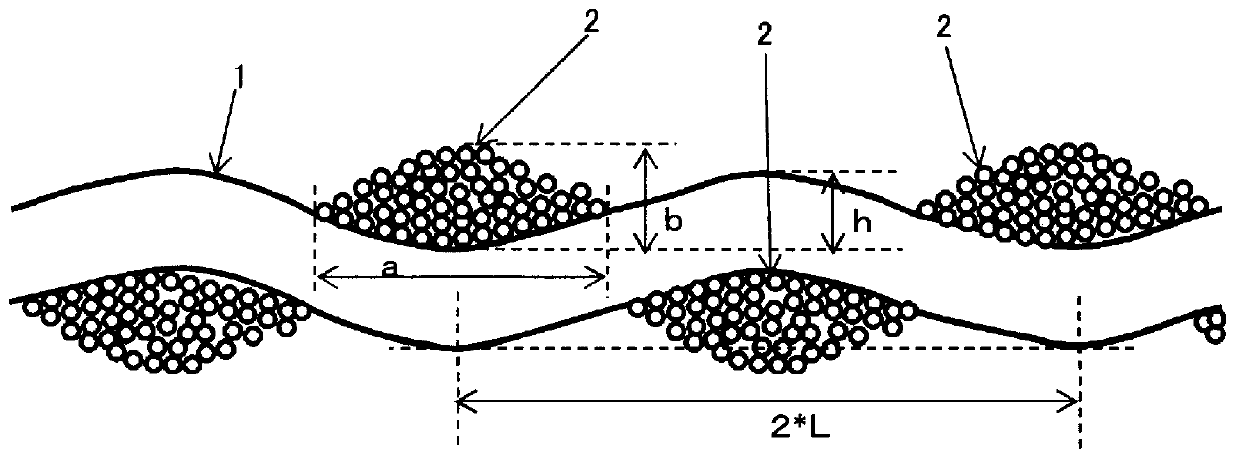the fabric
A fabric and fiber technology, applied in the direction of fabrics, woven fabrics, textiles, etc., can solve problems such as poor skin touch, thick fabric products, and reduced air permeability, and achieve excellent skin touch, excellent durability, and wear resistance. improved effect
- Summary
- Abstract
- Description
- Claims
- Application Information
AI Technical Summary
Problems solved by technology
Method used
Image
Examples
Embodiment 1~4 and comparative example 1~4
[0155] As a core component, "Hytrel" (registered trademark) 6347 (melting point: 215° C.) manufactured by Toray Dupont, which is a thermoplastic polyester elastomer, was used as a core component, and “Hytrel” (registered trademark) 4056 (melting point: 153° C.) was used as a sheath component. After each pellet was dried, it was melted with a separate extruder, and each was metered by a gear pump and flowed into a composite module, and supplied to the extruder to obtain a 700dtex product with a mass ratio of core: sheath = 70:30. Monofilament elastic yarn. The bending rigidity of this elastic yarn was 1.0 cN, and it was used as a weft yarn.
[0156] In addition, 10 167dtex-48 filament yarns of a cationic dyeable polyester yarn (LOCII manufactured by Toray Co., Ltd.) were spun. The obtained filament yarn with a total fineness of 1670 dtex-480 was twisted so that the warp twist coefficient was shown in Table 1, and the obtained yarn was used as the warp. Adjust the warp yarn te...
Embodiment 5
[0160] As a thermoplastic polyester-based elastomer, Toray Dupont "Hitorel" (registered trademark) 6347 (melting point: 215° C.) was prepared as a core component. In addition, "HITREL" (registered trademark) 4056 (melting point: 153° C.) was prepared as a sheath component. After drying each pellet, melt it with a separate extruder, meter it with a gear pump, flow it into a composite module, and supply it to the extruder to obtain a 400dtex product with a mass ratio of core: sheath = 70:30. Monofilament elastic yarn. The bending rigidity of this elastic yarn was 0.3 cN, and this elastic yarn was used as a weft.
[0161] Five 167dtex-48 filament yarns of cationic dyeable polyester yarn (LOCII manufactured by Toray) were spun. The obtained filament yarn of 835 dtex-240 in total fineness was twisted so that the warp twist coefficient became 2890, and the obtained yarn was used as a warp. Adjust the warp yarn tension and other weaving conditions, make the plain weave fabric reco...
Embodiment 6~8 and comparative example 5、6
[0164] Pellets of "HITREL" (registered trademark) 6347 (melting point: 215° C.) manufactured by Toray Dupont, which is a thermoplastic polyester elastomer, were dried. Then, it was melted by an extruder, metered by a gear pump, flowed into a composite module, and supplied to an extruder to obtain a monofilament elastic yarn of 700 dtex. This elastic yarn is used as a weft. In addition, as a warp, 10 167dtex-48 filament yarns of a cationic dyeable polyester yarn (LOCII manufactured by Toray Co., Ltd.) were spun. The resulting filaments of 1670 dtex-480 in total fineness were twisted so that the warp twist coefficients are shown in Table 1. Weaving conditions such as warp tension were adjusted to produce plain weave fabrics shown in Table 1. The obtained fabric was heat-treated at a temperature of 180° C. for 1 minute by using a pin tenter to make the in-and-out widths uniform, and the overfeed rate in the warp direction was 0%. Then, dyeing processing was carried out accordi...
PUM
| Property | Measurement | Unit |
|---|---|---|
| melting point | aaaaa | aaaaa |
| melting point | aaaaa | aaaaa |
| cover factor | aaaaa | aaaaa |
Abstract
Description
Claims
Application Information
 Login to View More
Login to View More - R&D
- Intellectual Property
- Life Sciences
- Materials
- Tech Scout
- Unparalleled Data Quality
- Higher Quality Content
- 60% Fewer Hallucinations
Browse by: Latest US Patents, China's latest patents, Technical Efficacy Thesaurus, Application Domain, Technology Topic, Popular Technical Reports.
© 2025 PatSnap. All rights reserved.Legal|Privacy policy|Modern Slavery Act Transparency Statement|Sitemap|About US| Contact US: help@patsnap.com



